Difference between revisions of "Time of fruit ripening"
| Line 115: | Line 115: | ||
| LEACS2 || NM_001247249 || [http://www.ncbi.nlm.nih.gov/nuccore/NM_001247249.1] || Tomato || Example | | LEACS2 || NM_001247249 || [http://www.ncbi.nlm.nih.gov/nuccore/NM_001247249.1] || Tomato || Example | ||
|- | |- | ||
| − | | LEACS1A || | + | | LEACS1A || 544028 || [http://www.ncbi.nlm.nih.gov/gene/?term=LEACS1A] || Tomato || Example |
|- | |- | ||
| LeMADS-MC || AF448521 || [http://www.ncbi.nlm.nih.gov/nuccore/20219013] || Tomato || Example | | LeMADS-MC || AF448521 || [http://www.ncbi.nlm.nih.gov/nuccore/20219013] || Tomato || Example | ||
| Line 127: | Line 127: | ||
| TC12359/TM29 || NP_001233911 || [http://www.ncbi.nlm.nih.gov/protein/NP_001233911.1] || Tomato || Example | | TC12359/TM29 || NP_001233911 || [http://www.ncbi.nlm.nih.gov/protein/NP_001233911.1] || Tomato || Example | ||
|- | |- | ||
| − | | TC117868|| | + | | TC117868|| ESTs only || Example || Tomato || Example |
|- | |- | ||
| − | | TC124330 || | + | | TC124330 || ESTs only || Example || Tomato || Example |
|- | |- | ||
| SEP29 || Example || Example || Example || Example | | SEP29 || Example || Example || Example || Example | ||
| Line 135: | Line 135: | ||
| LEMEMADS || Example || Example || Example || Example | | LEMEMADS || Example || Example || Example || Example | ||
|- | |- | ||
| − | | Ap1 || | + | | Ap1 or LeAP1|| Gene: 543886 GeneBank: AY306154.1|| [http://www.ncbi.nlm.nih.gov/nuccore/32478032] || Tomato || Example |
|- | |- | ||
| − | | FUL || | + | | FUL || GeneBank: NC_012020.3 Gene ID: 100232953|| [http://www.ncbi.nlm.nih.gov/gene/100232953] || grape || Example |
|- | |- | ||
| − | | AGL3|| | + | | AGL3/SEP4|| Gene ID: 814898 || [http://www.ncbi.nlm.nih.gov/gene/814898] || Arabidopsis thaliana || Example |
|- | |- | ||
| LeMADS-RN || Example || Example || Example || Example | | LeMADS-RN || Example || Example || Example || Example | ||
Revision as of 18:27, 14 February 2013
Fruit is classified on a physiological basis as climacteric (presence) or nonclimateric (absence) of increased respiration and synthesis from ethylene (File:Giovannoni2004.pdf). Blueberries like strawberries and grapes are nonclimacteric fruit and capable of ripening in the absence of increased ethylene synthesis. The distinctions between climacteric and nonclimacteric are poorly understood. It is suggested that nonclimacteric phenotypes may represent mutations in ethylene synthesis, but both types have common regulatory mechanisms. Therefore, I will look at gene involved in ripening for both climateric and nonclimacteric fruit in hopes to piece together genes in blueberry involved in time of fruit ripening.
Ethylene and Fruit Ripening All information from (File:BarryandGiovannoni2007.pdf)
Fruits have a great diversity, but aspects of ripening between fleshy fruits are often conserved. Ripening is associated the color change, altered sugar metabolism, softening, aroma, and in increased susceptibility to pathogen infection. Therefore, genetic mechanism that underly these processes may be conserved between species.
Ethylene synthesis at the onset of ripening is required for the normal ripening of many fruits.
Brief Analysis of Steps: 1) conversion of methionine to S-adenosyl-L-methionine (SAM) catalyzed by the enzyme SAM synthetase
(2) formation of 1- aminocyclopropane-1-carboxylic acid (ACC) from SAM via ACC synthase (ACS) activity
(3) the conversion of ACC to ethylene, which is catalyzed by ACC oxidase (ACO). The formation of ACC also leads to the production of 5¢-methylthioadenosine MTA), which is recycled via the methionine cycle to yield a new molecule of methionine.
Steps See Tutorial: [1]
Ethylene Pathway:
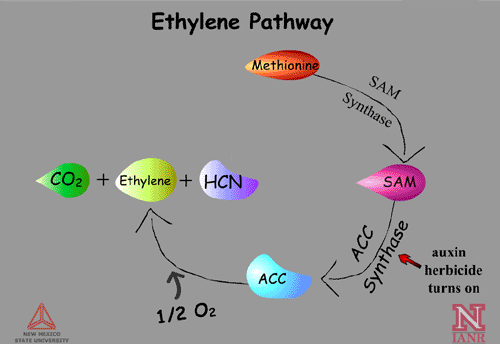
From: [[2]]
There are 2 systems of Ethylene synthesis: 1. Is autoinhibitory, such that exogenous ethylene inhibits synthesis, and inhibitors of ethylene action can stimulate ethylene production
2. Is stimulated by ethylene and is therefore autocatalytic, and inhibitors of ethylene action inhibit ethylene production

LEACO1, LEACO3, and LEACO4 are expressed at low levels in green fruit that are in a system 1 mode of ethylene synthesis, but the transcripts of each increase at the onset of ripening as the fruit transitions to system 2 ethylene production and response. During ripening, LEACO1 and LEACO4 are sustained in expression, whereas the increase in LEACO3 expression is transient (Barry and others 1996; Nakatsuka and others 1998). LEACS6 is expressed in wild-type green fruit but rapidly declines at the onset of ripening during the transition to system 2 ethylene synthesis. Therefore, pursuing genes LEACO1, LEACO3, LEACO4, LEACS6 could be beneficial in since they regulate the transitions of the ethylene synthesis and the onset of fruit ripening.
Tomato: The tomato is a model system for climateric fruit.
1. The rate limiting step in ethylene synthesis is the conversion of S-adenosylmethionine to 1-amino-cyclopropane-1carboxylic acid (ACC) via ACS synthases. ACS genes LeACS1A, LeACS4, LeACS2 and LeACS6 are under developmental control and are responsible for the initiation of ripening ethylene. Both are induced at the onset of ripening, and this induction is impaired by mutation at the ripening-inhibitor (rin) locus (Barry et al., 2000). Fruit homozygous for the rin mutation fail to exhibit ripening associated with ethylene production. Therefore, these genes would be good genes to look into.
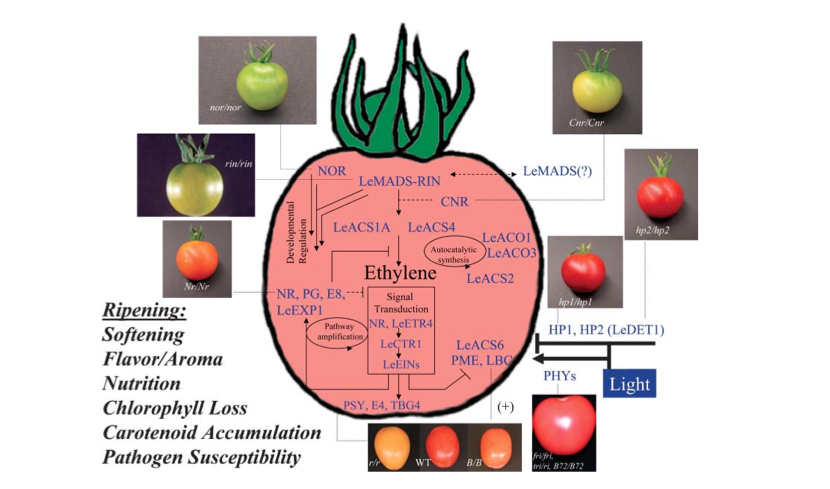
With the exception of ethylene, the signaling pathways that regulate fruit ripening remain largely undefined.
2. In tomato, three pleiotropic nonripening mutants, ripening-inhibitor (rin), non-ripening (nor), and Colorless non-ripening (Cnr), have been described in which virtually all aspects of the ripening process are inhibited (Thompson and others 1999; Tigchelaar and others 1978). In these three mutants, the typical ripening-associated rise in autocatalytic ethylene synthesis is blocked due to abnormal regulation of ACS expression. It is suggested that rin, nor, and Cnr act upstream of ethylene in the ripening cascade and determine the competency of the fruit to ripen. Therefore, genes at these three loci would be good candidates to study.
3. rin Locus:
On rin locus there are family genes called the MAS box genes which together with the rin locus regulate timing of ethylene synthesis. These same genes were found in strawberry suggesting that a conserved function of MADs box proteins in regulating ripening. LeMADS-MC, which is expressed in immature and ripe fruit and TDR4, TDR6, TAG1, TC125359/TM29, TC117868, and TC124330 are thus candidates for genes encoding MADS box proteins that may interact with LeMADS-RIN. In addition, TAG1 and SEP29 have been repressed in transgenic tomatoes.
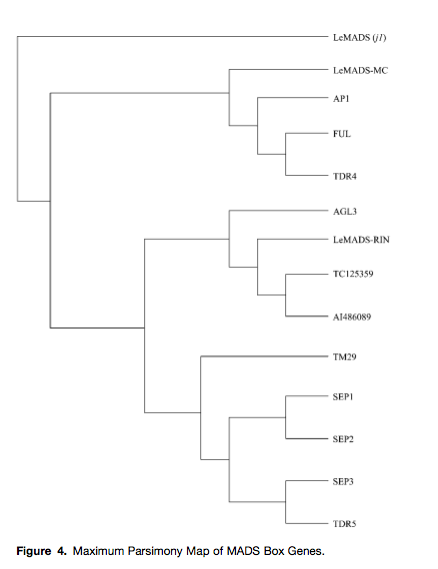
4. Cnr locus
Cnr mutation is the result of hypermethlayion of SQUAMOSA PROMOTER BINDING PROTEIN (SBP) gene that regulated the expression of MADS-box genes. Therefore, CNR may infleunce RIN expression and MADS box genes during fruit ripening.
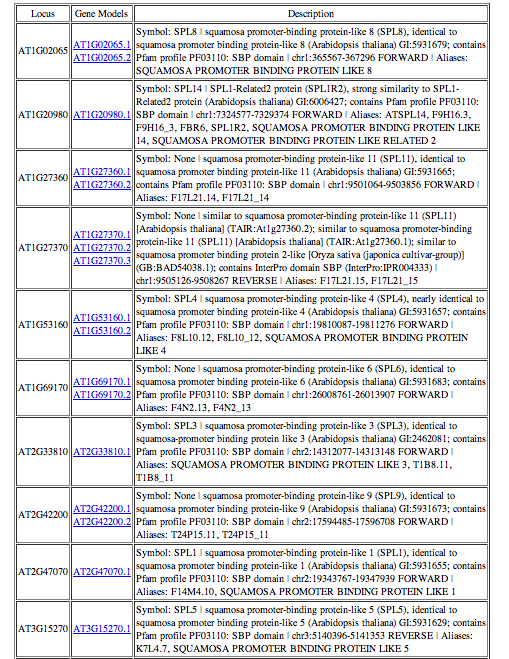
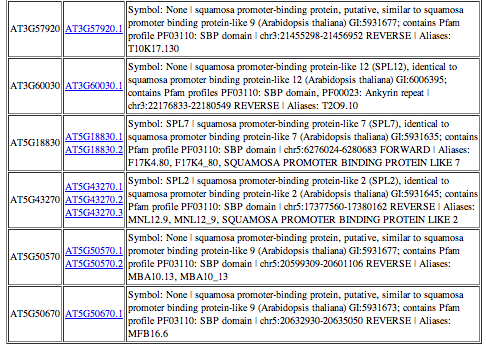
From: [3]
Strawberry:
Is the most widely studied nonclimacteric ripening fruit
1. The GAST-like genes are known to play a role in fruit ripening. GAST-like gene, FaGAST1 and FaGAST2 from strawberry shows an increases in throughout fruit receptacle development and ripening. related to the fruit size during development. Both are needed to work together for fruit cell size during fruit ripening and therefore, could be candidates for search in the blueberry (Moyano-Canete et al. 2012). Accession number: GenBank GW402389.1
2. In tomato it has been shown that SEP4-like gene is necessary for ripening in tomato and in strawberry FaMADS9 gene has been shown to control development in non-climateric fruit. FaMADs( controls ripening and development of the petal, achene, and receptacle tissues (Seymour et al. 2010). Accession number: GenBank AF484683.
3. A strawberry-related AAT gene, FaAAT2, involved in biosynthesis of esters that contribute to fruit flavor would a good candidate to see how different aspects of ripening occur (Cumpildo-Laso et al. 2012). Accession Number: JN089766
4. Fahyprp gene is involved anchoring polymeric polyphenols that are regulated by auxins. Auxin is essential for the biosynthesis of ethylene and therefore, would a be a good candidate to look for in blueberry (Blanco-Portales et al. 2004).
5. Auxin produced by achenes represses ripening of fruit but is key for fruit growth. Therefore, it is speculated that ripening-enhanced genes is regulated by auxin. Below is table of genes that are co-orinated with auxin and support ripening of fruit.
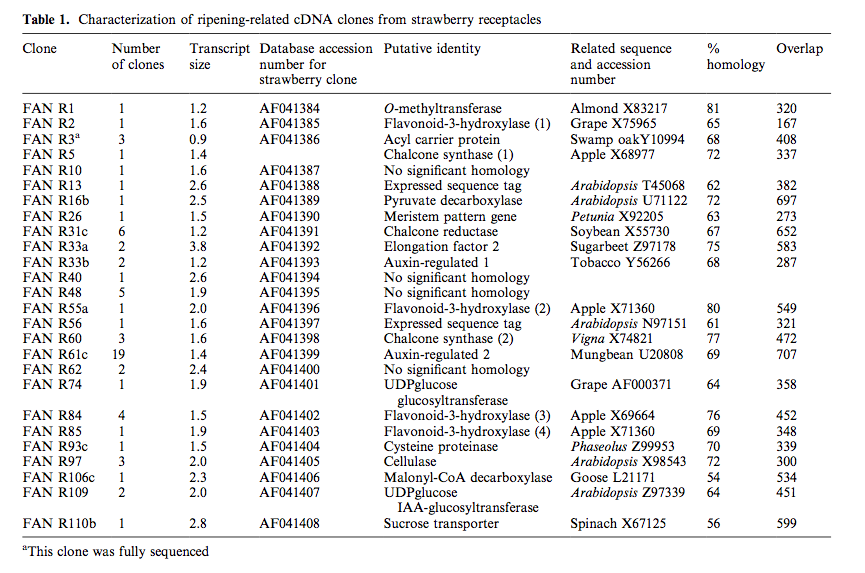
6. Cystathionine-gamma-synthase (CGS) and ACC oxidase genes have been reported during the ripening of strawberry (Aharoni and others 2002; Marty and others 2000; Trainotti and others 2005)
7. FaETR2 a homolog fo LeETRA is associated with ripening (Trainotti and others 2005)
8. Peptide methionine sulfoxide reductase (PMSR) gene that is expressed late in strawberry ripening would be a candidate (Pedraza-Lopez and others 2006). It is homologous to the tomato ripening-related gene E4, whose expression is regulated by ethylene in tomato and may be involved in the methionine salvage pathway that operates during increased ethylene synthesis (Lincoln and others 1987).
Grape:
KEGG Ripening Synthesis Pathway in Vitis vinifera (wine grape): [4]

1. serine/threonine-protein kinase CTR1 [EC:2.7.11.1]: NCBI-GI: 359481975 NCBI-GeneID: 100240856
2. ETR1- ethylene receptor-like [EC:2.7.13.-]
3. nitogen-activated protein kinase 6 [EC:2.7.11.24]: NCBI-GI: 359478277 NCBI-GeneID: 100242320
4. ethylene-insensitive protein 2:NCBI-GI: 225440009 NCBI-GeneID: 100256742 UniProt: F6HR32
5. EIN3-binding F-box protein NCBI-GI: 225430289 NCBI-GeneID: 100249270 UniProt: F6H327
6. ethylene-insensitive protein 3 NCBI-GI: 359496557 NCBI-GeneID: 100245518 UniProt: F6HRG8
7. ethylene-responsive transcription factor 1 NCBI-GI: 225437872 NCBI-GeneID: 100246426 UniProt: F6HZJ0
| Gene Name | Accession Number | Sequence | Species | Source | |
|---|---|---|---|---|---|
| LEACO1 | NP_001234024.1 | [5] | Tomato | Example | |
| LEACS6 | AAL50559 | [6] | Tobacco | Example | |
| LEACS4 | AF548375 | [7] | Tomato | Example | |
| LEACS2 | NM_001247249 | [8] | Tomato | Example | |
| LEACS1A | 544028 | [9] | Tomato | Example | |
| LeMADS-MC | AF448521 | [10] | Tomato | Example | |
| TDR4 | NM_001247614 | [11] | Tomato | Example | |
| TDR6 | X60759 | [12] | Tomato | Example | |
| TAG1 | AAP35239 | [13] | Tomato | Example | |
| TC12359/TM29 | NP_001233911 | [14] | Tomato | Example | |
| TC117868 | ESTs only | Example | Tomato | Example | |
| TC124330 | ESTs only | Example | Tomato | Example | |
| SEP29 | Example | Example | Example | Example | |
| LEMEMADS | Example | Example | Example | Example | |
| Ap1 or LeAP1 | Gene: 543886 GeneBank: AY306154.1 | [15] | Tomato | Example | |
| FUL | GeneBank: NC_012020.3 Gene ID: 100232953 | [16] | grape | Example | |
| AGL3/SEP4 | Gene ID: 814898 | [17] | Arabidopsis thaliana | Example | |
| LeMADS-RN | Example | Example | Example | Example | |
| A1486089 | Example | Example | Example | Example | |
| TM29 | Example | Example | Example | Example | |
| SEP1 | 831436 | [18] | Arabidopsis thaliana | Example | |
| SEP2 | Example | Example | Example | Example | |
| SEP3 | Example | Example | Example | Example | |
| AT1G02065 | Example | Example | Example | Example | |
| AT1G20980 | Example | Example | Example | Example | |
| AT1G27360 | Example | Example | Example | Example | |
| AT1G27370 | Example | Example | Example | Example | |
| AT1G53160 | Example | Example | Example | Example | |
| AT1G69170 | Example | Example | Example | Example | |
| AT2G33810 | Example | Example | Example | Example | |
| AT2G42200 | Example | Example | Example | Example | |
| AT2G47070 | Example | Example | Example | Example | |
| AT3G15270 | Example | Example | Example | Example | |
| AT3G57920 | Example | Example | Example | Example | |
| AT3G60030 | Example | Example | Example | Example | |
| AT5G18830 | Example | Example | Example | Example | |
| AT5G43270 | Example | Example | Example | Example | |
| AT5G50570 | Example | Example | Example | Example | |
| AT5G0670 | Example | Example | Example | Example | |
| FaGAST1 | Example | Example | Example | Example | |
| FaGAST2 | Example | Example | Example | Example | |
| FaMADS9 | Example | Example | Example | Example | |
| FaAAT2 | Example | Example | Example | Example | |
| Fahyprp | Example | Example | Example | Example | |
| FAn R1 | Example | Example | Example | Example | |
| FAN R2 | Example | Example | Example | Example | |
| FAn R3 | Example | Example | Example | Example | |
| FAN R5 | Example | Example | Example | Example | |
| FAN R10 | Example | Example | Example | Example | |
| FAN R13 | Example | Example | Example | Example | |
| FAN R16b | Example | Example | Example | Example | |
| FAN R26 | Example | Example | Example | Example | |
| FAn R31c | Example | Example | Example | Example | |
| FAn R33a | Example | Example | Example | Example | |
| FAN R40 | Example | Example | Example | Example | |
| FAn R48 | Example | Example | Example | Example | |
| FAN R55a | Example | Example | Example | Example | |
| FAN R56 | Example | Example | Example | Example | |
| FAN R60 | Example | Example | Example | Example | |
| FAn R61c | Example | Example | Example | Example | |
| FAN R62 | Example | Example | Example | Example | |
| FAN R74 | Example | Example | Example | Example | |
| FAN R84 | Example | Example | Example | Example | |
| FAN R85 | Example | Example | Example | Example | |
| FAN R93c | Example | Example | Example | Example | |
| FAN R97 | Example | Example | Example | Example | |
| FAN R106c | Example | Example | Example | Example | |
| FAN R109 | Example | Example | Example | Example | |
| FAN R110b | Example | Example | Example | Example | |
| FaETR2 | Example | Example | Example | Example | |
| LeETRA | Example | Example | Example | Example | |
| E4 | Example | Example | Example | Example | |
| PMSR | Example | Example | Example | Example | |
| CTR1 | Example | Example | Example | Example | |
| ETR1 | Example | Example | Example | Example | |
| MPK6 | Example | Example | Example | Example | |
| EIN2 | Example | Example | Example | Example | |
| EBF1/2 | Example | Example | Example | Example | |
| EIN3 | Example | Example | Example | Example | |
| ERF1/2 | Example | Example | Example | Example |